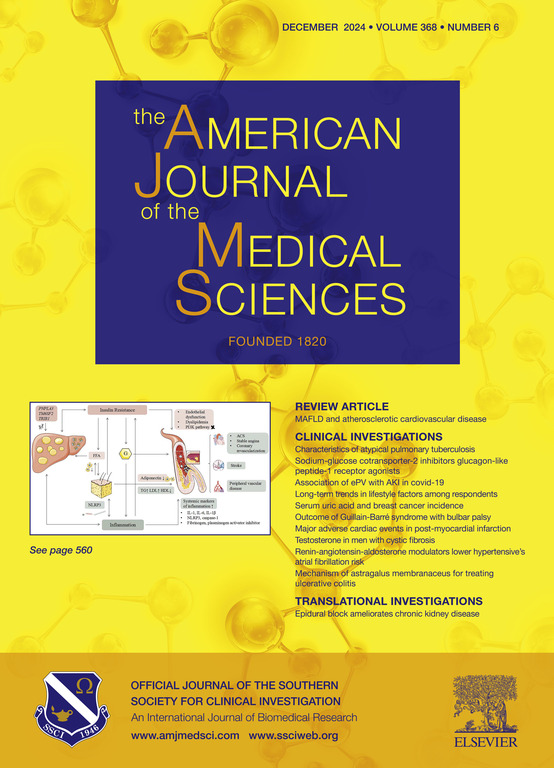HBP、PCT和CRP在鉴定重症COVID-19细菌性并发症中的诊断价值
IF 1.8
4区 医学
Q2 MEDICINE, GENERAL & INTERNAL
引用次数: 0
摘要
背景:为了应对COVID-19危重患者延迟细菌感染诊断的挑战,我们评估了血清降钙素原(PCT)、c反应蛋白(CRP)和肝素结合蛋白(HBP)的性能,以及支气管肺泡灌洗液HBP作为指导抗生素治疗的潜在生物标志物。方法:将符合COVID-19重型和危重型纳入标准的患者作为病例组,选择年龄和性别匹配的健康个体作为对照组。测量PCT、CRP和HBP水平。根据细菌培养结果进一步对病例组进行分层,并对血清、痰液或支气管肺泡灌洗液标志物的差异进行统计分析。结果:细菌感染患者血浆PCT和HBP水平均明显高于新冠肺炎组和健康对照组,而CRP仅在与健康对照组区分时才有显著性差异。PCT鉴别COVID-19与细菌感染的AUC为0.937,敏感性为0.828,特异性为0.933;CRP的AUC为0.564,敏感性为0.828,特异性为0.400。HBP的AUC为0.775,敏感性为0.690,特异性为0.967。PCT+CRP+HBP联合检测诊断效果最好,AUC为0.978,灵敏度为0.966,特异性为0.933。结论:PCT、CRP和HBP联合检测可对合并细菌感染的COVID-19患者进行更精确的分类,并为最佳的抗生素起始时间提供信息。本文章由计算机程序翻译,如有差异,请以英文原文为准。
Diagnostic Utility of HBP, PCT, and CRP in Identifying Bacterial Complications in Severe COVID-19
Background
To address the challenge of delayed bacterial infection diagnosis in critically ill COVID-19 patients, we evaluated the performance of serum procalcitonin (PCT), C-reactive protein (CRP), and heparin-binding protein (HBP), and bronchoalveolar lavage fluid HBP as potential biomarkers for guiding antibiotic therapy.
Methods
Patients meeting the inclusion criteria for severe and critical COVID-19 were enrolled as the case group, while age- and gender-matched healthy individuals were selected as the control group. Levels of PCT, CRP, and HBP were measured. The case group was further stratified based on bacterial culture results, and differences in serum, sputum, or bronchoalveolar lavage fluid markers were subjected to statistical analysis.
Results
Plasma levels of PCT and HBP were significantly higher in patients with bacterial infection compared to both the COVID-19 group and the healthy control group, while CRP was only significant in distinguishing cases from the healthy control group. The AUC for PCT in differentiating COVID-19 patients from those with bacterial infection was 0.937 with a sensitivity of 0.828 and specificity of 0.933, while the AUC for CRP was 0.564 with a sensitivity of 0.828 and specificity of 0.400. The AUC for HBP was 0.775 with a sensitivity of 0.690 and specificity of 0.967. The combined detection of PCT+CRP+HBP exhibited the highest diagnostic performance, with an AUC of 0.978, a sensitivity of 0.966, and a specificity of 0.933.
Conclusions
The combined detection of PCT, CRP, and HBP can enable more precise classification of COVID-19 patients with concurrent bacterial infections and inform the optimal timing of antibiotic initiation.
求助全文
通过发布文献求助,成功后即可免费获取论文全文。
去求助
来源期刊
CiteScore
4.40
自引率
0.00%
发文量
303
审稿时长
1.5 months
期刊介绍:
The American Journal of The Medical Sciences (AJMS), founded in 1820, is the 2nd oldest medical journal in the United States. The AJMS is the official journal of the Southern Society for Clinical Investigation (SSCI). The SSCI is dedicated to the advancement of medical research and the exchange of knowledge, information and ideas. Its members are committed to mentoring future generations of medical investigators and promoting careers in academic medicine. The AJMS publishes, on a monthly basis, peer-reviewed articles in the field of internal medicine and its subspecialties, which include:
Original clinical and basic science investigations
Review articles
Online Images in the Medical Sciences
Special Features Include:
Patient-Centered Focused Reviews
History of Medicine
The Science of Medical Education.

 求助内容:
求助内容: 应助结果提醒方式:
应助结果提醒方式:


